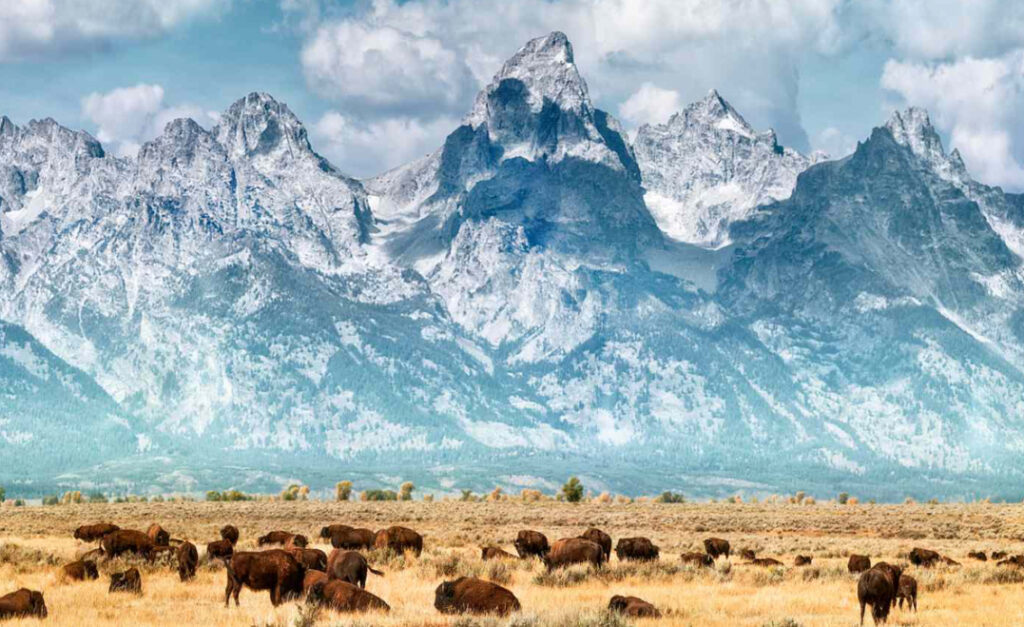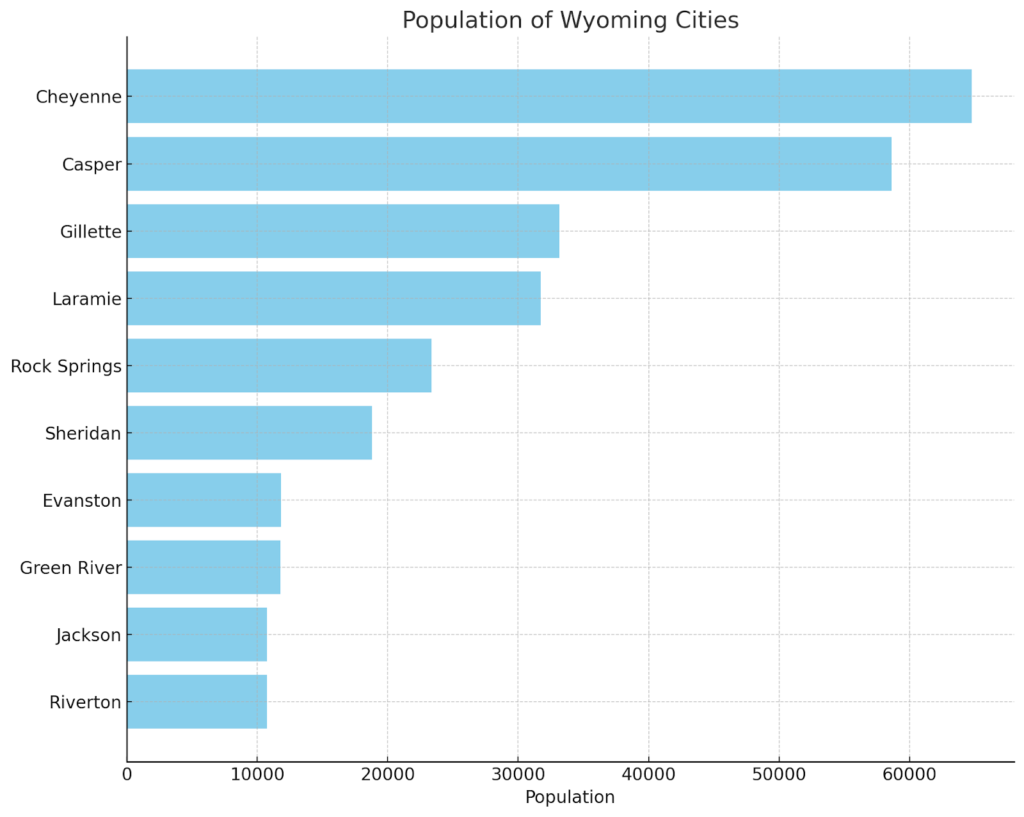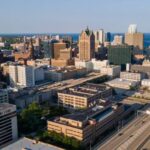
Wyoming, the least populous state in the United States, is known for its vast landscapes, rugged mountains, and open spaces. Despite its size, Wyoming’s cities are vibrant communities, each with their own unique character and charm. From the bustling streets of Cheyenne to the scenic beauty of Jackson, Wyoming’s cities offer a glimpse into the state’s rich history, culture, and natural beauty. This article ranks the top 10 cities in Wyoming by population, providing a detailed look at what makes each city special.
What are the Top Wyoming Cities by Population?

1. Cheyenne (Population: 64,795)
As the state capital and largest city, Cheyenne stands as the economic and political hub of Wyoming. Located in the southeastern corner of the state, Cheyenne is famous for the Cheyenne Frontier Days, the world’s largest outdoor rodeo. The city’s rich history is evident in its historic buildings and museums, while its growing economy is supported by a mix of government services, transportation, and manufacturing industries. Cheyenne’s commitment to arts and culture is showcased in its vibrant arts scene, with events like the Cheyenne Arts Festival and performances at the Cheyenne Civic Center. The Wyoming State Capitol, a National Historic Landmark, underscores the city’s political significance and architectural beauty. The city’s green spaces, like the Cheyenne Botanic Gardens and Lions Park, offer residents and visitors alike a place to enjoy the outdoors. Furthermore, Cheyenne’s strategic location makes it a key transportation and logistics hub, connecting the Rocky Mountain region with the rest of the country. Its mix of historical charm, cultural richness, and economic vitality makes Cheyenne a dynamic city that honors its past while looking forward to the future.
2. Casper (Population: 58,631)
Nestled in the heart of Wyoming, Casper is a key center for the petroleum and mineral industry, earning it the nickname “The Oil City.” Beyond its economic contributions, Casper offers abundant outdoor recreational opportunities, thanks to its proximity to Casper Mountain and the North Platte River. The city is also home to cultural institutions like the Nicolaysen Art Museum and the National Historic Trails Interpretive Center. Casper’s commitment to education and community development is evident in its support for the Casper College, one of the largest and most comprehensive community colleges in the region. The city’s recreational offerings include the Platte River Trails, a network of pathways that connect various parts of the city, promoting an active and engaged community. Casper’s events calendar is full of activities, from the annual Central Wyoming Fair & Rodeo to the Wyoming Eclipse Festival, highlighting the city’s ability to bring people together and celebrate its unique heritage and natural beauty. Casper’s blend of industry, culture, and recreation makes it a cornerstone of Wyoming’s economic and social landscape.
3. Gillette (Population: 33,158)
Known as the “Energy Capital of the Nation,” Gillette’s economy thrives on coal, oil, and methane gas production. Located in northeastern Wyoming, it serves as a vital link to the Powder River Basin, one of the largest coal mining regions in the world. Despite its industrial roots, Gillette boasts a strong community spirit, with numerous parks, recreational facilities, and an active cultural scene. The city’s forward-looking approach is exemplified by the Gillette Energy Complex, which includes research and development in renewable energy sources, reflecting a commitment to sustainable growth. Gillette’s CAM-PLEX Multi-Event Facilities offer a venue for events ranging from rodeos to concerts, emphasizing the city’s role as a regional entertainment hub. The city also values outdoor recreation, with the nearby Thunder Basin National Grassland providing opportunities for hiking, hunting, and wildlife observation. Gillette’s blend of economic strength, community engagement, and commitment to sustainability positions it as a leader in Wyoming’s future development, balancing industrial growth with environmental stewardship and quality of life.
4. Laramie (Population: 31,735)
Laramie is a picturesque city that embodies Wyoming’s blend of education, culture, and outdoor adventure. Home to the University of Wyoming, Laramie offers a vibrant academic and cultural environment, with museums, theaters, and galleries. The city’s location near the Snowy Range Mountains provides easy access to skiing, hiking, and fishing, making it a favorite among outdoor enthusiasts.
5. Rock Springs (Population: 23,361)
Rock Springs’ history is rooted in mining and the railroad, which has shaped its diverse community. Today, the city is known for its cultural festivals, including the International Days celebration, which reflects its multicultural heritage. Rock Springs also serves as a gateway to the Flaming Gorge National Recreation Area, offering outdoor activities like fishing, boating, and camping.
6. Sheridan (Population: 18,807)
Sheridan charms visitors and residents alike with its historic downtown, western heritage, and vibrant arts scene. The city is surrounded by scenic mountain ranges, including the Bighorn Mountains, providing ample opportunities for outdoor recreation. Sheridan’s commitment to the arts is evident in its galleries, public artworks, and the annual Sheridan WYO Rodeo, a highlight of the local cultural calendar.
7. Evanston (Population: 11,801)
Evanston is a small city with a big heart, known for its beautiful historic architecture and community events. Situated near the Utah border, it serves as a gateway to the Uinta Mountains, offering outdoor adventures in all seasons. Evanston’s Bear River State Park is a popular spot for wildlife viewing, picnicking, and trails. The city’s charm is further accentuated by its vibrant Main Street, where local businesses thrive alongside historic buildings that tell the story of Evanston’s rich past. The annual Evanston Cowboy Days, one of the oldest rodeos in Wyoming, showcases the city’s deep-rooted cowboy culture with thrilling performances, parades, and family-friendly events. Moreover, the Uinta County Museum, located in the historic Carnegie Library, offers insights into the region’s history and heritage, making it a must-visit for history buffs. Evanston’s community-focused initiatives, such as its local farmers’ markets and arts festivals, foster a sense of belonging and highlight its commitment to sustainability and local craftsmanship.
8. Green River (Population: 11,772)
Green River’s stunning natural setting is defined by the river that runs through it, offering spectacular scenery and outdoor activities like fishing, boating, and river rafting. The city is also known for its commitment to preserving natural habitats, with several parks and the Seedskadee National Wildlife Refuge nearby. Green River’s annual River Festival celebrates the community’s close relationship with the river and its environment. This commitment extends to the Green River Greenbelt, a path that offers residents and visitors a scenic route for walking, biking, and observing local wildlife. The city’s dedication to the arts is evident in its public art installations and the Sweetwater County Art Museum, which showcases regional artists’ work. Furthermore, the Expedition Island Park, the launch site of John Wesley Powell’s 1869 river expedition, is a historical landmark and a center for community gatherings, underscoring Green River’s blend of natural beauty and historical significance. The city’s efforts in conservation and outdoor recreation make it a model for sustainable living and a haven for nature enthusiasts.
9. Jackson (Population: 10,748)
Jackson is a renowned tourist destination, famous for its proximity to Grand Teton and Yellowstone National Parks. The city’s downtown area, with its iconic antler arches, offers a mix of art galleries, boutiques, and dining options. Jackson Hole Mountain Resort attracts skiing and snowboarding enthusiasts from around the world, making Jackson a year-round destination for adventure. Beyond its outdoor attractions, Jackson is a cultural hub with the National Museum of Wildlife Art, which houses a vast collection of wildlife art that celebrates the area’s natural heritage. The city also hosts the annual Jackson Hole Film Festival, attracting filmmakers and cinephiles alike. Jackson’s commitment to conservation is evident in its eco-friendly initiatives and support for wildlife conservation organizations. The local community is deeply engaged in preserving the natural beauty and wildlife that make Jackson unique. Additionally, the Teton County Fair showcases the region’s agricultural heritage and offers entertainment, livestock competitions, and rodeo events, further enriching Jackson’s cultural landscape. This blend of natural beauty, cultural richness, and community engagement makes Jackson a standout destination in Wyoming.
10. Riverton (Population: 10,733)
Riverton lies at the heart of the Wind River Valley and serves as a hub for agriculture, mining, and the energy industry. The city’s location makes it a prime spot for exploring the nearby Wind River Range and the Arapaho and Shoshone tribal lands. Riverton’s community events, like the annual 1838 Mountain Man Rendezvous, celebrate the area’s history and culture.
Wyoming’s cities, though small by national standards, offer a rich tapestry of American life. From the energy boomtowns to the serene mountain communities, each city contributes to the state’s diverse culture and economy. Whether drawn by the promise of adventure in the great outdoors or the allure of small-town charm, visitors and residents alike find something special in the cities of Wyoming.
Last modified: February 29, 2024
